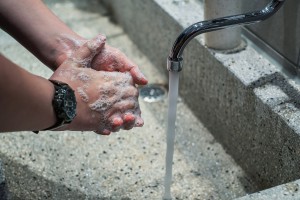
World Hand Hygiene Day: 5 May
Geneva: For many infectious pathogens, including SARS-CoV-2, good hand hygiene practices are tremendously important for reducing the risk of transmission, as part of a wider package of public health and infection prevention and control (IPC) measures. COVID-19 has dramatically demonstrated just how important good hand hygiene practices are in reducing the risk of transmission, when used as part of a comprehensive package of preventative measures.
As more and more people today realise, health workers, patients and families, infection prevention and control practitioners, health facility managers, policy-makers, vaccinators and the general public all have an important role to play and are encouraged to practice good hand hygiene, because appropriate hand hygiene:
- reduces the risk of infection from many pathogens, including SARS-CoV-2, both in the general population, and among health workers.
- prevents up to 50% of avoidable infections acquired during health care delivery.
However, despite overwhelming evidence showing the impact of good hand hygiene practices, many gaps still exist that show inadequate infrastructure and supplies leading to gaps in hand washing behaviour, in particular in health care. For example:
- Globally, 1 in 4 health care facilities do not have access to basic water services.
- 1 in 3 facilities lack hand hygiene resources at the point of care, 6 and in low-income countries only 17% of facilities have continuous availability of alcohol-based hand rub supplies, compared to 75% in high-income countries.
- Compliance with hand hygiene best practices is only around 9% during care of critically ill patients in low income countries, while levels of hand hygiene compliance for high-income countries rarely exceed 70%.
This year, in the Year of Health and Care Workers, WHHD 2021 focuses on achieving effective hand hygiene action at the point of care and redouble our efforts to ensure that hand hygiene is a priority for action. Hand Hygiene Day, May 5, is more important than ever, to help sustain the promotion of this basic but critical action. The World Health Organization’s latest global survey on implementation of national infection prevention and control (IPC) programmes highlights the urgent need to reduce inequalities in the availability of good hand hygiene and other infection prevention and control measures between high and lower income countries.
The survey shows that infection acquired during health care delivery is a major global health problem, but patients in low- and middle-income countries are twice as likely to experience this as patients in high-income countries (15% and 7% of patients respectively); the risk in intensive care units (ICU), especially among newborns, is between 2 and 20 times higher. One reason for this is that in some low-income countries only 1 in 10 health workers practises proper hand hygiene while caring for patients at high risk of health care-associated infections in ICU – often because they simply do not have the facilities to do so.
Investing in hand hygiene yields huge returns – hand hygiene policies can generate economic savings averaging 16 times the cost of their implementation. WHO provides guidance on the resources considerations needed for making such an investment across the health system and WHHD 2021 represents a critical time for everyone to show commitment to hand hygiene improvement.
Through the global Hand Hygiene for All initiative, WHO and UNICEF call upon policy and decision makers to invest in hand hygiene improvement as a whole-of-society effort, and show tangible action to strengthen the enabling environment and ensure vital hand hygiene products and WASH services are readily accessible, across the health system, and for everyone in their community.
Effective hand hygiene reduces mortality and disabilities due to health care-associated infections. Seconds save lives – Clean your hands!
– global bihari bureau





